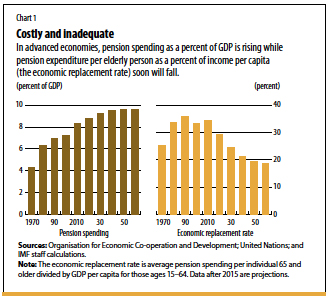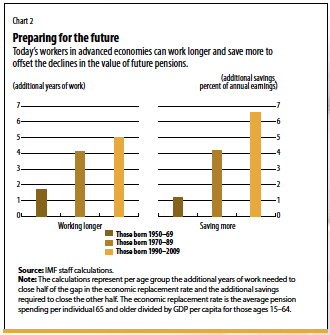Pension Shock
Finance & Development, June 2017, Vol. 54, No. 2
Young adults in advanced economies must take steps to increase their retirement income security

Public pensions have played a crucial role in ensuring retirement income security over the past few decades. But for the millennial generation coming of working age now, the prospect is that public pensions won’t provide as large a safety net as they did to earlier generations. As a result, millennials should take steps to supplement their retirement income.
Pensions and other types of public transfers have long been an important source of income for the elderly, accounting for more than 60 percent of their income in countries that are members of the Organisation for Economic Co-operation and Development (OECD). Pensions also reduce poverty. Without them, poverty rates among those over 65 also would be much higher in advanced economies.
Pressure on pensions
But pensions are also costly to provide. Government spending on pensions has been increasing in advanced economies from an average of 4 percent of GDP in 1970 to close to 9 percent in 2015—largely reflecting population aging (see Chart 1, left panel).

Population aging puts pressure on pension systems by increasing the ratio of elderly beneficiaries to younger workers, who typically contribute to funding these benefits. The pressure on retirement systems is exacerbated by increasing longevity—life expectancy at age 65 is projected to increase by about one year a decade.
To deal with the costs of aging, many countries have initiated significant pension reforms, aiming largely at containing the growth in the number of pensioners—typically by increasing retirement ages or tightening eligibility rules—and reducing the size of pensions, usually by adjusting benefit formulas. Since the 1980s, public pension expenditure per elderly person as a percent of income per capita—the so-called economic replacement rate—has been about 35 percent. But that replacement rate is projected to decline to less than 20 percent by 2060 (see Chart 1, right panel).
This means that younger generations will have to work longer and save more for retirement to achieve replacement rates similar to those of today’s retirees (see Chart 2):

Working longer: To close the gap in the economic replacement rate relative to today’s retirees, one option for younger individuals is to lengthen their productive work lives. For those born between 1990 and 2009, who will start to retire in 2055, increasing retirement ages by five years—from today’s average of 63 to 68 in 2060—would close half of the gap relative to today’s retirees. A longer work life can be justified by increased longevity. But prolonging work lives also has many benefits. It enhances long-term economic growth and helps governments’ ability to sustain tax and spending policies. Working longer can also help people maintain their physical, mental, and cognitive health (Staudinger and others 2016). However, efforts to promote longer work lives should be accompanied by adequate provisions to protect the poor, whose life expectancy tends to be shorter than average (Chetty and others 2016).
Saving more: Simulations suggest that if those born between 1990 and 2009 put aside about 6 percent of their earnings each year, they would close half of the gap in economic replacement rate relative to today’s retirees. In practice, relying on people’s private savings for retirement requires a hard-to-achieve mix of fortune and savvy. First, individuals need continuous and stable earnings over their careers to be able to save sufficient amounts. Second, workers would have to be able to decide how much to put aside each year and how to invest their savings. Third, the risks from uncertain or low returns are borne by individuals. Finally, workers would have to decide how fast to consume their savings during retirement. These are all complex decisions, and people can make mistakes at each step along the way (Munnel and Sundén 2004).
Time to cope
For younger generations, acting early is crucial to ensure retirement income security, especially because longevity gains are projected to continue. As millennials start to enter the workforce, retirement might be the last thing on their mind. But with many governments retrenching their role in providing retirement income, younger workers need to work longer and step up their retirement savings.
Governments can make it easier for individuals to remain in the workforce at older ages by reviewing taxes and benefits that might favor early retirement. Nudges to encourage workers to save can also help, for example by automatically enrolling them in private retirement saving plans. For example, starting in 2018, the United Kingdom will require employers to automatically enroll workers in a pension program. Boosting financial literacy and making the workplace more friendly to older workers can also be part of the solution.
The good news for younger workers is that retirement is some four decades away, allowing time to plan for longer careers and to put money aside for later. But they must start now.
References
Chetty, Raj, and others. 2016. “The Association Between Income and Life Expectancy in the United States, 2001–2014.” JAMA 315 (16): 1750–766.
Munnell, Alicia H., and Annika Sundén. 2004. Coming Up Short: The Challenge of 401(k) Plans. Washington, DC: Brookings Institution Press.
Staudinger, Ursula M., and others. 2016. “A Global View on the Effects of Work on Health in Later Life.” Gerontologist 56 (Suppl 2): S281–92.


